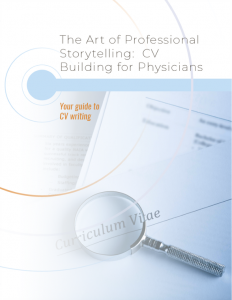Though we’ve covered the basics of writing an effective physician CV, it’s always good to have a refresher on the basics. This is especially true if you’ve just finished crafting your physician CV and are ready to send it out — a final proofreading is always in order.
Here are five tips you should always rely on before sending your CV to a potential employer:
1) Keep Your Physician CV Under Two Pages
No matter how accomplished you are, you should never submit a CV that’s over two pages. If you’re having trouble condensing your CV, the best way to shorten it is to create an addendum, which is a separate document with more information you can provide upon request.
Of course, you want your physician CV to be as thorough as possible. In addition to education and training, you’ll also want to list things like employment, publications, volunteer work and research. Try to keep it simultaneously brief and comprehensive. Shorten those things that you think are least relevant to the position you’re going after.
2) Make Sure Your Physician CV is Easy to Read
Though several things contribute to an easy-to-read CV, formatting and white space are two biggies.
White space is the “breathing room” on your CV. Ever notice how it’s easier (and faster) to read bullet points than it is to read an entire page chock full of text? White space, or the blank area surrounding the text on the page, makes a CV pleasant to look at and easy to read.
Consistent formatting is also important, and you should look for it when you proofread your physician CV. For instance, if you put one job title in bold text, be sure to put all of your other job titles in bold text. Keep the style of your CV uniform and clean for a strong impression.
3) Place All Dates on the Right Side of the Page
It might not seem like a very big deal, but it’s important to put dates after positions. Here’s an example:
2002-2007, M.D., University of Illinois at Chicago
MD., University of Illinois at Chicago, 2002-2007
Did you find yourself focusing on the date in the first example? And more on the actual position and school in the second example?
While dates are important, you should always emphasize accomplishments more than dates. This makes important information easier to access and process for busy recruiters and employers.
4) Check (and Double-Check!) Your Contact Information
Your physician CV is useless if you don’t provide the right contact information. It seems like a total no-brainer, but a typo in your phone number or e-mail address can make it impossible for a recruiter or potential employer to contact you.
Double-check all of your contact information before sending out your CV. Say the numbers of your phone number or the letters of your e-mail address aloud to yourself to catch mistakes. It takes a little extra time, but it’s well worth the effort.
5) Aim for Chronological Order
Typically, your physician CV should appear in reverse chronological order. Start with your most recent accomplishments, working backwards in time as your CV progresses.
Anyone who picks up your CV should be able to get a good idea of your career trajectory in under a minute.
In some cases, it’s acceptable to put accomplishments in an order that isn’t chronological. For instance, if you think it would be best to highlight your educational experience, it’s fine to list that first, as long as your CV still makes chronological sense.
The most important thing is to make sure nothing in your CV looks “buried.” If you intentionally try to cover up gaps in dates, employers will be able to tell. It’s always best to be honest, straightforward and clear. If necessary, explain any inconsistencies or exceptions briefly in Your Guide to Writing The Perfect Cover Letter.
To read more on The Art of Professional Storytelling: CV Building for Physicians by author Tanja Getter in the Career and Life Planning Guidebook for Medical Residents, follow this link: Your guide to CV writing










